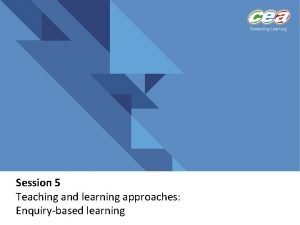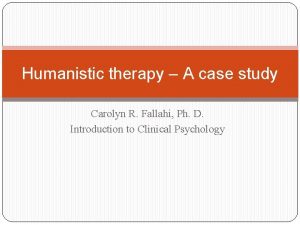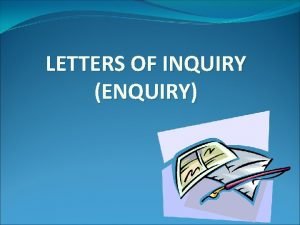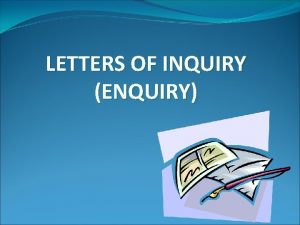Case study 2 Using an enquiry approach Steyning








- Slides: 8

Case study 2: Using an enquiry approach Steyning Grammar School, Steyning, West Sussex Year 7 June 2009

(1) What was the department trying to achieve? • • The geography teachers at Steyning Grammar School (a comprehensive school in West Sussex) had been developing their system of assessment for some time, as part of a pilot project for the Qualifications and Curriculum Authority (QCA) They wanted to extend the enquiry skills of their students in key stage 3 and saw an opportunity to adapt a long-running field trip to the Cuckmere Valley. This had previously been a traditional ‘walk and talk’ field excursion. The aim was to put more responsibility for learning on the students and ask them to gather a wider range of evidence than previously in order to tackle an enquiry question. The Cuckmere Valley is an area of outstanding natural beauty within the South Downs of East Sussex. Parts of the valley are likely to be subject to increased river and coastal flooding as the Environment Agency introduces its policy of ‘managed retreat’ in the near future. The teachers wanted students to decide for themselves if the valley should be allowed to ‘return to the sea’.

(2) How did the teacher organise the learning? • The teacher gave them a ‘mystery’ enquiry question in order to capture their interest • Students were allocated a role to play throughout the day • Students were given structured activities and asked to gather evidence to help ‘solve’ the mystery • Dialogue was encouraged throughout the day to help develop emerging ideas and test evidence

Strategy 1: creating a need to know • “Mysteries can completely transform the teaching and learning process … [they] are designed to encourage pupils to deal with ambiguity through addressing a question which has no single correct answer and where they are not even sure what information is relevant – rather like real life in fact” Leat (1998) • The department designed a mystery question to engage students’ interest. • Intrigue was generated as the question was seen as ‘unusual’ and did not seem at first to have anything to do with the place they had arrived in. • The subject of the question was a character of interest to this age group – but the connection to ‘geography’ was less than obvious!

Does Harry Potter need to conjure up more shingle for Cuckmere Haven? Note for teachers: one of the coastguard cottages threatened with coastal erosion is owned by a senior member of Bloomsbury – publishers of the Harry Potter series!

Strategy 2: using role play • • The teachers wanted to avoid creating ‘identikit’ characters (e. g. “an environmentalist”) The teachers researched a number of REAL people and agencies involved in the debate and provided students with information about these people This created opportunities for complex opinions and for students to see the actual places where some of the ‘characters’ lived and worked Students were provided with some quotes but were asked to work out the attitude of their character towards the ‘managed retreat’ issue for themselves – The owner of one of the coastguard cottages at Cuckmere Haven threatened with coastal erosion – The local publican fearful of the impacts on business – The chairperson of the Cuckmere Estuary Partnership (representing local councils, county councils and landowners such as the National Trust) – The Sussex area manager for the Environment Agency Student roles

Strategy 3: gathering evidence • Small groups of students worked together to gather a range of evidence about the area • Some secondary information was also made available during the day. Students had to decide which evidence would be useful to their arguments Methods included: • Describing the present land use • Assessing the current management of the area • Evaluating the landscape value • Evaluating the ecological value

Strategy 4: encouraging dialogue • The teachers wanted to avoid a gap between ‘data gathering’ and ‘making sense of the data’ • They felt the best chance of understanding the issue would come on site – not back in the classroom • They built in group discussion, ‘mini-plenaries’ and chances for different ‘characters’ to talk together during the day













